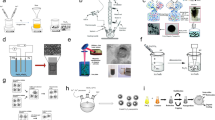Abstract
Purpose
2-(2-nitro-1H-imidazol-1-yl)-N-(2,2,3,3,3-pentafluoropropyl)-acetamide labeled with [18F]-fluorine ([18F]EF5), a promising tracer for tumor hypoxia, has previously been synthesized in low yields and low specific radioactivity. In pharmacokinetic evaluations, in the presence of non-radioactive EF5, a uniform and low background uptake and high in vivo stability of [18F]EF5 have been demonstrated. Our purpose was to increase the specific radioactivity of [18F]EF5 to enable to study the pharmacokinetics at trace level.
Procedures
[18F]EF5 was synthesized using high specific radioactivity electrophilic [18F]F2 as labelling reagent. Biodistribution of [18F]EF5 was determined in a prostate tumor mouse model, and formation of radiolabelled metabolites was studied in mouse, rat and human plasma.
Results
On average, 595 ± 153 MBq of [18F]EF5 was produced. Specific radioactivity was 6.6 ± 1.9 GBq/μmol and the radiochemical purity exceeded 99.0%. [18F]EF5 was distributed uniformly in tissues, with highest uptake in liver, kidney, and intestine. Several radiolabelled metabolites were detected in mouse plasma and tissues, whereas low amounts of metabolites were detected in human and rat plasma.
Conclusions
[18F]EF5 was synthesized by electrophilic labelling with high quality and high yields. Pharmacokinetics of [18F]EF5 was determined at trace level in several species. Our results suggest that the trace-level approach does not affect the biodistribution of [18F]EF5. Extensive metabolism was seen in mouse.





Similar content being viewed by others
References
Hoogsteen IJ, Marres HA, van der Kogel AJ, Kaanders JH (2007) The hypoxic tumour microenvironment, patient selection and hypoxia-modifying treatments. Clin Oncol 19:385–396
Brown JM, Wilson WR (2004) Exploiting tumour hypoxia in cancer treatment. Nat Rev Cancer 4:437–447
Varghese AJ, Gulyas S, Mohindra JK (1976) Hypoxia-dependent reduction of 1-(2-nitro-1-imidazolyl)-3-methoxy-2-propanol by Chinese hamster ovary cells and KHT tumor cells in vitro and in vivo. Cancer Res 36:3761–3765
Nunn A, Linder K, Strauss HW (1995) Nitroimidazoles and imaging of hypoxia. Eur J Nucl Med 22:265–280
Krohn KA, Link JM, Mason RP (2008) Molecular imaging of hypoxia. J Nucl Med 49:129S–148S
Minn H, Grönroos TJ, Komar G et al (2008) Imaging of tumor hypoxia to predict treatment sensitivity. Curr Pharm Des 14:2932–2942
Lapi SE, Voller TF, Welch MJ (2009) Positron emission tomography imaging of hypoxia. PET Clin 4:39–47
Ziemer LS, Evans SM, Kachur AV et al (2003) Noninvasive imaging of tumor hypoxia in rats using the 2-nitroimidazole 18F-EF5. Eur J Nucl Med Mol Imaging 30:259–366
Koch CJ, Evans SM (2003) Non-invasive PET and SPECT imaging of tissue hypoxia using isotopically labeled 2-nitroimidazoles. Adv Exp Med Biol 510:285–292
Evans SM, Kachur AV, Schiue CY et al (2000) Noninvasive detection of tumour hypoxia using the 2-nitroimidazole [18F]EF1. J Nucl Med 41:327–336
Mahy P, De Bast M, Leveque PH et al (2004) Preclinical validation of the hypoxia tracer 2-(2-nitroimidazol-1-yl)-N-(3,3,3-[18F]trifluoropropyl)acetamide, [18F]EF3. Eur J Nucl Med Mol Imaging 31:1263–1272
Dubois L, Landuyt W, Cloetens L et al (2008) [18F]EF3 is not superior to [18F]FMISO for PET-based hypoxia evaluation as measured in a rat rhabdomyosarcoma tumour model. Eur J Nucl Med Mol Imaging 36:209–218
Dolbier WR, Li AR, Koch CJ, Shiue CY, Kachur AV (2001) [18F]-EF5, a marker for PET detection of hypoxia: synthesis of precursor and a new fluorination procedure. Appl Radiat Isot 54:73–80
Bergman J, Solin O (1997) Fluorine-18-labeled fluorine gas for synthesis of tracer molecules. Nucl Med Biol 24:677–683
Laughlin KM, Evans SM, Jenkins WT et al (1996) Biodistribution of the nitroimidazole EF5 (2-[2-nitro-1H-imidazol-1-yl]-N-(2,2,3,3,3-pentafluoropropyl) acetamide) in mice bearing subcutaneous EMT6 tumors. J Pharmacol Exp Ther 277:1049–1057
Komar G, Seppänen M, Eskola O et al (2008) 18F-EF5: a new PET tracer for imaging hypoxia in head and neck cancer. J Nucl Med 49:1–8
Evans SM, Koch CJ (2003) Prognostic significance of tumor oxygenation in humans. Cancer Lett 195:1–16
Koch CJ, Hahn SM, Rockwell K, Covey JM, McKenna WG, Evans SM (2001) Pharmacokinetics of EF5 [2-(2-nitro-1-H-imidazole-1-yl)-N-(2,2,3,3,3-pentafluoropropyl) acetamide] in human patients: implications for hypoxia measurements in vivo by 2-nitroimidazoles. Cancer Chemother Pharmacol 48:177–187
Acknowledgements
This work was supported in part by the European Union's FP6 Commission “Biocare” (Molecular Imaging for Biologically Optimized Cancer Therapy) under the contract number 505785. Additional funding was obtained from The Finnish Cancer Organizations, Foundation for the Finnish Cancer Institute, the Hospital District of Southwest Finland's EVO-foundation, and the Academy of Finland (grant number 116084).The authors wish to thank Professor Cameron Koch (Radiation Oncology Department, School of Medicine, University of Pennsylvania, Philadelphia, USA) and the US National Cancer Institute for providing EF5 and its precursor free of charge.
Conflict of Interest
The authors declare that they have no conflict of interest.
Author information
Authors and Affiliations
Corresponding author
Rights and permissions
About this article
Cite this article
Eskola, O., Grönroos, T.J., Forsback, S. et al. Tracer Level Electrophilic Synthesis and Pharmacokinetics of the Hypoxia Tracer [18F]EF5. Mol Imaging Biol 14, 205–212 (2012). https://doi.org/10.1007/s11307-011-0484-4
Published:
Issue Date:
DOI: https://doi.org/10.1007/s11307-011-0484-4




